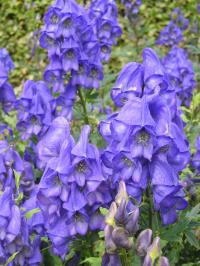Monkshood or Aconites
 Aconitum carmichaelii, one of many different species of Aconitum
Aconitum carmichaelii, one of many different species of AconitumWhile beautiful Monkshood (Aconites) are also extremely poisonous, so always handle with care when working with these plants.
Like many other garden plants, Aconitum carmichaelii (pictured), a member of the Genus of plants collectively known as the Monkshood or Aconites, needs to be shown some respect when you handle it because it is highly poisonous! If I am working on an Aconitum in the garden, maybe doing some deadheading or cutting the spent flower spikes right down at the end of the growing season, I will consider wearing a pair of gloves and certainly thoroughly wash my hands afterwards just in case I have exposed my hands to any sap.
Getting the sap on your hands may only cause skin irritation, but if you consequently manage to get that sap in your mouth then you might well end up meeting your maker a bit prematurely. If fact, the term Aconitum is derived from the Greek for ‘dart’, a reference to how arrows were once dipped in the sap of Monkshood Aconites to improve the arrow’s potential to kill it’s target.
There is no harm in researching the plants in your garden and finding out which ones you should be careful with, especially if there are likely to be young children in the garden that might be attracted to colourful flowers or bright berries that actually highlight a more sinister quality.
Imagine the hood of a monk’s cape sheltering him from the elements on a blustery autumn night and it’s easy to see the resemblance to the flowers of the Monkshood Aconites. The flowers are produced on upright flower spikes above leaves that often resemble maple leaves, being lobed with 3-5 fingers.
There are some Aconitums such as Aconitum carmichealii that flower in autumn in many gardens, they provide some welcome colour in borders sometimes lacking colour at this time of year. The habit and flower colour of these plants mean that the more horticulturally challenged amongst us often confuse them for Delphiniums. If the long hot summer days are becoming a distant memory and you are missing the cool colours of the Delphiniums, you can use the blues and violets of the autumn flowering Aconitums to relive your summer enjoyment.
There are about 100 different species of Aconitum. In the wild they can be found growing amongst the grasslands and scrub of mountainous regions in the Northern Hemisphere. I am often surprised at the advice given for growing certain garden plants. Imagine what the conditions must be like on those mountainous hillsides, I would expect plants native to such areas to be growing in exposed sites, often in full sun. I would expect the rocky soil to be poor and shallow, maybe drying out frequently.
However, the conventional advice for growing Monkshood Aconites is to grow them in nutritious, moist, fertile, deep soil and to grow them in a lightly shaded position.
My advice then would be to try growing Aconitum in a variety of soil types and positions around the garden and not necessarily follow the conventional advice.
Monkshood Aconite make good cut flowers but before you hand over your bunch of seasonal blooms to your nearest and dearest, be sure to warn them of the danger hidden behind the hood.
Filed under Perennials.

